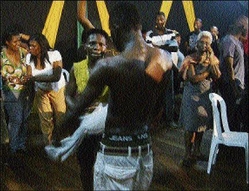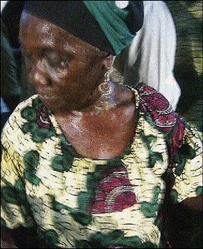Spirits awoken at Trevor Rhone's wake
Published: Sunday | October 4, 2009


Photos by Paul Williams
LEFT: A woman at Trevor Rhone's wake assists a man who was caught up in myal, as the Seaforth Kumina Group from St Thomas performed on Wednesday night at the Ranny Williams Entertainment Centre.
RIGHT: An elderly member of the Seaforth Kumina Group in her element at Trevor Rhone's wake.
Paul H. Williams, Gleaner Writer
A wake is a vigil held over a body before a burial, but at the one held for the late world-renowned Jamaican playwright, Trevor Rhone, there was no corpse. And it may have been a good thing that there wasn't. For, Rhone certainly would have risen from his casket to witness the melange of spirits that clashed at Ranny Williams Entertainment Centre Wednesday night.
Organised by the Jamaica Association of Dramatic Artists, its president Dorothy Cunningham, and playwright and producer Basil Dawkins, it was an evening of spellbinding and spine-chilling singing, drumming and dancing from the Manchioneal Cultural Group from Portland, the Seaforth Dust to Dawn Kumina Group from St Thomas, the St Ann Senior Citizens' Group and the Turbo Plastics Duppy Band from Portland, which opened the musical feast with their brightly painted plastic 'drums'.
Traditional songs
Singing traditional wake and Revival songs, accompanied by old graters, 'shake-shakes', tambourines and drums, and dressed in a variety of colourful costumes, the groups delved passionately into their heritage of music and dance. The singing, though off-key at moments, was dramatic, soul-stirring and contagious. Some patrons had no choice than to join in, and it was not long before there was a crowd around the drummers and singers.
In an anti-clockwise direction, patrons and performers moved in tandem to the hypnotic sounds of the drums. Old and young gyrated and twirled, some shuffling their feet as they moved along. Some youths put some modern twists to these ancient movements, but those lacked the poignancy of the belly-rolling and hip-swinging of the elderly women, who spun and rocked, nonetheless in unison with the youths who were young enough to be their great-grandsons. It was the old meeting the young, belly to belly, back to back, in a sort of ritualistic passing of the baton of cultural heritage.
Outside, under a huge white tent, people met and greeted, played dominoes, hobnobbed and sipped free drinks. The atmosphere was festive, and there was food aplenty. Jamaican fare, including salt fish 'flittas', was also there for the taking. Many persons from the Jamaican theatre fraternity were out to celebrate the life of their former colleague, but a particular actor, very popular on the roots theatre stage, was ubiquitous with his blue and white hair, and seemed not to be moved by the electrifying and sometimes syncopated rhythms of the drums.
Musical celebration
The musical celebration culminated with Dust to Dawn Kumina Group. And what a climax it was! Led in song, mostly by the very tall Whitmore Simpson, the group of young and elderly people transported the onlookers back to another place and time with energetic and animated drumming. They beat the drums mercilessly as sweat oozed through their pores, soaking their shirts. Not only were they communicating with the drums, but their eyes pierced each other's and those of some patrons.
In wild abandon people danced, because the Kumina drums would not let them stay still. In a strong voice, Simpson, obviously an expert at what he does, led the way in Jamaican Creole and remnants of, he later explained, Congo language. White rum to appease the spirits of the ancestors was sprinkled at random into the air, and as the intoxicating scent permeated the compact gathering the drummers became invigorated, and the dancers, some letting out banshee-like wails, twirled into another realm.
A young woman in short shorts and a tight blouse was the first to fall prey to the myal (a trancelike state). With a spaced-out look, she moved as if led by an unseen force as other singers and dancers tried to prop her up. For several minutes, she was not herself, moving around seemingly aimlessly. People watched in awe as she sprinkled rum into the crowd and after what seemed like an eternity of directions from the 'other side', she dashed from the stage and disappeared in the night.
Ancestors appeared unsatisfied
But it would appear as if the ancestors were not satisfied. As soon as the young woman exited a young man, drenched in sweat, and with eyes as red as a rolling calf's, appeared to be dazed. With hands at his waist, he moved in an awkward manner to the beat of the drums; then he raised his hands slowly into the air. With eyes now closed, he's led by a woman in a bright yellow blouse. She pranced around him, shaking him, flailing her hand across his face, as if to awake him.
The youth was gone, taken away by the myal, and he paid her no mind. She then took off his shirt, danced with him, coerced him, and was successful in getting him to sit in a chair, where he sat quietly, and still, while the drums played and people danced, and the scent of white rum stung the nostrils of the mesmerised patrons.
It was a night of the spirits - the spirit of togetherness, of those long and recently dead, and the spirit of the indomitable Jamaican people.
paul.williams@gleanerjm.com
















